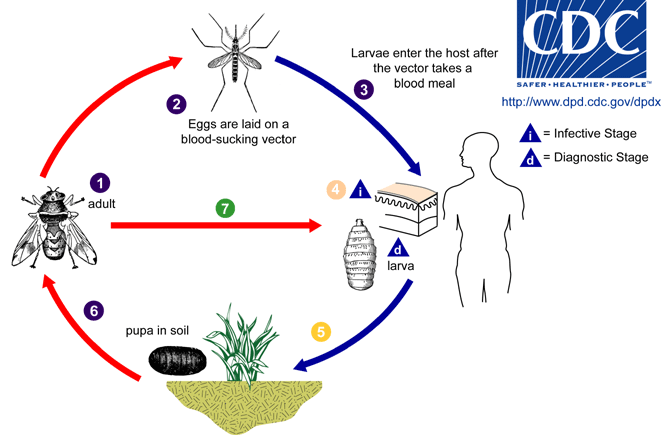Reproduction
Dermatobia hominis has a very complex and well researched life
cycle that includes other organisms. Adult Botflies live for a short
period of time, anywhere between 2-19 days. Within this adult time
frame the botfly doesn’t eat but instead relies on nutrients
acquired from larval stages (Bangsgaard, 2000). The adult female
will start producing eggs within two days of reaching adulthood, the
number of eggs produced is usually ranged from 100-200. The amazing
part of the botfly life cycle occurs when the adult female D.
hominis is ready to deposit its eggs. The adult female will capture
an insect mid-flight and place its eggs on the body of an insect.
This process is usually repeated about 20 times, wherein all of the
eggs are dispersed (Guse, 1997). The insect vector is usually a
mosquito or some other blood sucking fly (Lane et al., 1987). The
process of capturing another insect for egg dissemination is
referred to as phoresis. Around 20 eggs are placed on the abdomen of
the insect. Adherence of the eggs to the body of the insect is
reliant on glue produced by D. hominis (Maier, 2004).The selection
of insect vector is dependent on the environment and possible hosts.
D. hominis has adapted to thick skinned hosts by selecting ticks and
flies that are more capable of penetrating thick skin. Another
adaptation that has occurred is the selection of insects that feed
on the shaded parts of a host, usually the legs or stomach, in order
to combat dry environments. (Maier, 2004). 
The eggs are then carried to a host by the insect vector while the larvae remain in the eggs until contact with the host occurs. The heat released by the host activates the eggs and causes the larvae to emerge. The larvae enter the host either by direct invasion on exposed skin, through the site where the insect penetrated the skin, or through a fair follicle (Guse, 1997). The larvae once in the skin reside in the subcutis feeding on the host’s tissue.
While in the host the larva will undergo three larval instar stages, or transformations, in which the larva change shape
(Maier, 2004). The first stage starts upon emergence from eggs and
once under the skin the larva will develop into a dome shape. The
larva although under the skin still need to breathe meaning an
external opening must be present. Removal of the larva through the
opening is difficult due to the concentric ring of spines present on
the body and the shape of the larva whose body is larger in the
front than the back (Lane, 1987). Respiration is accomplished
through openings on the posterior aspect of the larva called
spiracles (Guse, 1997). Duration of larva development in skin can
last anywhere from five to ten weeks, which can be dependent on
conditions and whether the larva is disturbed or not. The now fully
developed larva will emerge from the skin and drop to the soil where
pupation occurs. Success of pupation is reliant on climate, in which
warm and humid conditions are favored. The pupation process takes
about two to three weeks to complete, resulting in an adult fly
(Maier, 2004).
Keep reading, for more interesting information head to
Interactions